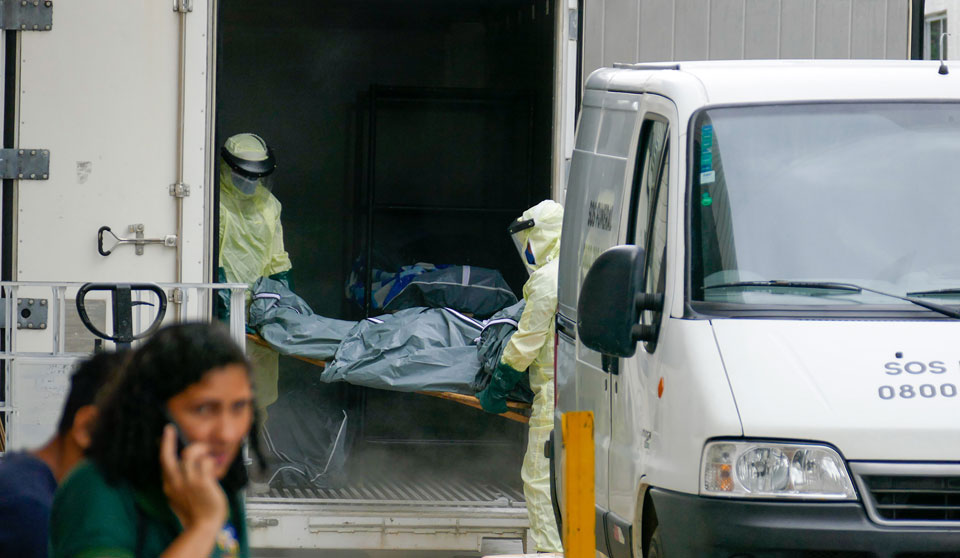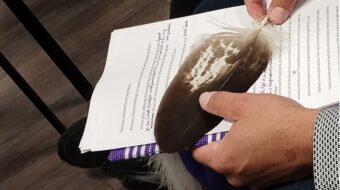
Manaus, Amazonas (January 4, 2021) – Amazonas State went into the purple phase of the new coronavirus pandemic, signifying the highest risk. The information was publicized by the director-president of the Health Vigilance Foundation (FVS) of Amazonas, Rosemary Costa Pinto, during a meeting between state representatives and officials of the Federal Ministry of Health. “Our risk analysis is that we are at an extremely high level of risk. We have exited the red high risk phase and entered the purple phase of very high risk,” she warned.
According to the National Council of Health Secretaries (CONASS), the purple phase is one of the five color-coded risk classifications that offer a way to evaluate a health system’s capacity for medical care as well as the epidemiological profile of COVID-19 cases. The risks can be very low (green), low (yellow), moderate (orange), high (red) and very high (purple). In the purple phase, maximum distancing is recommended and quarantine is mandated by official documents or decrees.
It was on the basis of a technical opinion from the FVS that the Amazonas State Judiciary decreed, this Saturday, the suspension of all commercial activities in the state for 15 days. The director-president of the FVS confirmed that the number of COVID-19 cases, hospital admissions and deaths are the contributing factors of a purple phase declaration.
“We had an increase of 120% in the number of cases in Manaus between November and December, when we passed from 1,573 to 3,452 cases, and an increase of 47% at the state level, expanding from 3,690 to 5,431 cases in the same period,” Rosemary Pinto confirmed. “Today we have a mobile median of 700 new cases every day. In terms of deaths, in the last 14 days we had a mobile median increase of 66%. The week before last, December 20-26, there was an increase from 86 deaths to 99 deaths on the 53rd and final week of the year (December 27-January 2),” the director concluded her remarks on the gravity of the pandemic during a time of municipal elections and year’s end festivities.
The following infographic shows that 152 people died between 12/27/20 and 01/02/21:

Ever since COVID-19 deaths and cases regained alarming levels in Amazonas last November, the government hurried to open beds in clinics and ICUs, some of them, maternity wards and cancer treatment clinics, causing controversy. Governor Wilson Lima went so far as to publish a decree prohibiting end-of-year crowds, but then withdrew it under pressure from local business owners. Now he must cede to a judicial decision prohibiting any kind of commerce for 15 days. But for State Prosecutor Silvana Nobre, more energetic action is needed to combat the pandemic.
“There is no possibility of restraining the pandemic just by offering to help, we need more than a helping hand to curtail the disease. Containing the pandemic will only be possible if we can suppress critical situations that lead to accelerated contamination,” the public prosecutor, a functionary of the Amazonas Public Ministry (MP-AM), warns.
With more than 5,000 deaths from COVID-19 and one of the most fragile healthcare systems in Brazil, the prosecutor defends the purpose of the Amazonas State Judiciary’s decision, published early on Saturday night, the 2nd of January: “The measure proposed by the MP-AM is designed to relieve the health network and above all, to save lives. The lack of emergency assistance is a result of the high level of contamination which is caused by masses of people in social situations.”
This Monday (January 4), the capital city of Amazonas, Manaus, had the highest number of hospitalizations since the beginning of the pandemic, with 177 people admitted. This pushed up the number of admissions in the state to 183. Manaus is the only one of the 62 state municipalities that has Intensive Care Units (ICU), where the gravest cases from the interior are sent. But even the recent addition of beds is insufficient. “We brought more beds into the clinics and ICUs of the capital’s public hospitals—Portuguese Beneficent Hospital and the Getúlio Vargas University Hospital—and took spare beds from suburban health centers, waiting rooms, emergency clinics. They’re completely full,” Silvana says.
At noon on the same day, Governor Wilson Lima held a press conference at which he presented disease data and the outline of a contingency plan. According to him, Amazonas increased the number of hospital beds from 457 to 1,070, of which 260 are in ICUs. The Delphina Aziz and Platão Araújo Hospitals are expressly for COVID-19 treatment, but the government has also assigned wards with beds for people with varying stages of the virus at four other city hospitals.
“If tomorrow the state created 200 new beds, they would all be immediately filled. If the next day they opened 400 more, they would be claimed as well, and this would still not be nearly enough,” Silvana explains.
Returning to the level of the worst months of the pandemic

The current scenario in Amazonas State is very similar to that of last April and May when the healthcare system collapsed due to the rapid spread of COVID-19. Now, the state has 1,508 people interned in public and private hospital networks. Of these, 1,126 are patients with confirmed cases and 382 are considered suspect and await diagnostic confirmation of their symptoms. The state has already registered 202,972 cases of the disease and 5,368 deaths. The Sars-CoV-2 virus has been detected in all the rivers and storm drains in Amazonas. It is also common to encounter Indigenous peoples who were or are infected in geographically isolated communities.
The following graphic charts when the second wave began:

The Amazonas State Tribunal, in a hearing concerning a civil action of the Public Ministry of Amazonas (MP-AM), determined that the government should suspend all non-essential activities in the state for 15 days. This measure, which includes an urgent request and a petition signed by eight promotors, principally affects the commercial sector. The government obeyed the decision by means of Decree No. 43,236/2020, which revalidated Decree No. 43,234, which had been revoked after commercial business owners protested its terms.
“What this verifies is that we are returning to the level of last May, and now we have more beds than we did then,” according to prosecutor Silvana. “We do not believe that the State exists only to lend a helping hand. We are dealing with human lives here. People are dying because of this disease, and you cannot say that there are relatively few casualties because each and every fatality is a father or a mother who leaves behind orphans and disrupted families. We cannot treat the death of any citizen as normal, especially one caused by a virus that can only be contained by the reduction of social gatherings,” she adds.
Pro-Bolsonaro Association tried to suspend the preliminary verdict

The Pan-Amazonian Association, a fellowship of entrepreneurs, most of whom are supporters of President Jair Bolsonaro (no party affiliation), tried to suspend the preliminary verdict conceded to the Public Ministry of Amazonas by the on-duty judge, Leoney Figliuolo Harraquian. By means of a petition for a security injunction, the Association argued that the judicial decision, besides affecting businesses linked to non-essential activities, could potentially affect formal and informal commerce. “The decision has the potential to damage the social fabric of Amazonia and the workers who depend on and serve the businesses for their subsistence,” reads a portion. The Pan-Amazonian document accuses the judicial ruling of taking away the right to work and free initiative and continues, in what seems a threatening tone, that this “will result in high levels of unemployment.” High court judge Délcio Santos rejected the Pan-Amazonian petition, pointing out that “a security injunction cannot counter a judicial act liable to recourse or correction.”
This reporter spoke with representatives of the commercial sector on Sunday and Monday, January 3 and 4. The president of the Federation of Amazonian Shop Owners Councils (FCDL), Ezra Azury Benzion, and the president of the Commercial Association of Amazonas (ACA-AM), Jorge Lima, said they would both prefer to make statements after the government had expressed its opinion. When we tried to contact them this afternoon, January 4, after the government declared that it will proceed according to the judicial decision, Benzion and Lima were not available.
The president of the Commercial Federation of Goods, Services and Tourism of the State of Amazonas (Fecomércio Amazonas), Aderson Frota, said that he understood the reason for the decision was the increase of the number of cases and the hospital overload, but added that commerce alone was not responsible for the situation: “What about the constitutional precepts? How can you generalize the responsibility for the rise in levels of contamination to an activity that is dedicated to serving the populace and, what is more, obeys all the safeguards and protective protocols? We think that the authorities should prove, with solid and salient data, that commerce is the general agent of the contamination. Of course, exceptions exist. In those cases, the State should act to restrain these foci and not generalize the blame, putting serious, responsible economic activity, jobs and their resultant social functions at risk. It is undisciplined people, not commerce, that breeds contamination,” according to Frota.
Indefinite emergency aid

Aderson Frota, president of the Fecomércio Amazonas, adds that the business community is worried about how the increase in unemployment and the end of emergency aid and other economic measures, like legal permission for a reduced workday and salaries, will play out.
“We must look, together with the federal government, for ways to defer measures that will prolong the pandemic’s economic impact,” Frota reasons. “After the convocation, we will speak with the government about this adversity and evaluate what can be done.”

In August, Amazonas registered one of the largest unemployment levels in Brazil. The unemployment rate rose to 17.9%, the country’s third largest, and affected 286,000 Amazonian inhabitants. According to National Household Research Sampling (PNAD), compiled by the Brazilian Institute of Geography and Statistics (IBGE), more than 60% of Amazonian households received emergency aid which was terminated in December 2020. The federal government has already informed the people that it will not renew the emergency measures. Amazonas State, like the rest of Brazil, has no certain date for the start of immunization. COVID-19 survivor President Jair Bolsonaro, who is affiliated with no political party at the moment, has taken a firm stand against combatting the disease, reiterating his opinion that people should circulate freely. He made a point of participating, without a facial covering, at a year’s end beach party in São Paulo State.
On a visit to health units in Manaus, Mayra Pinheiro, secretary of the Labor Administration and of Health Education in the Ministry of Health, announced that the federal government had earmarked 513 million Brazilian reais (5.4 reais = $1) in extraordinary resources for the fight against COVID-19 in Amazonas State. She visited with Governor Wilson Lima and, in a press conference, recommended the use of chloroquine as treatment for early onset of the disease. The drug has not been proven effective.
For MP Prosecutor Silvana Nobre, the present moment demands collective sobriety. “The struggle to escape from this chaos which affects not only the health system, but the whole society, requires the commitment of the entire population. We have to stop belittling the disease. It is both grave and serious and, depending on the degree of our commitment to actively combat it, may remain in our midst for a very long time. I am not talking about the commitment of just one public authority or of one institution, it is going to take all of us. If all of us unite in this battle, we will get out of this crisis more rapidly,” were Silvana Nobre’s last words.:
Translated for People’s World by Peter Lownds from Amazônia Real (January 4, 2021). N.B. Brazilians often refer to public persons by their first name, e.g., “Lula” and “Dilma.”












Comments